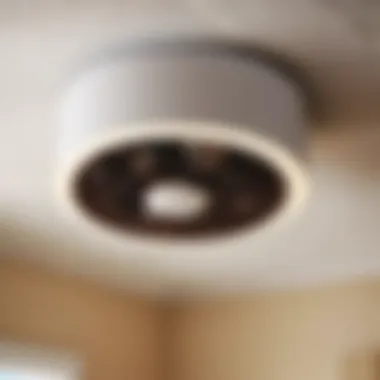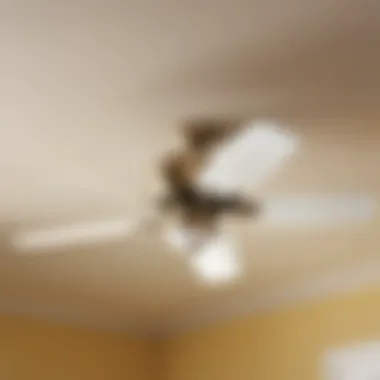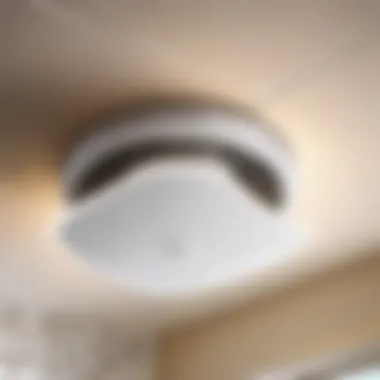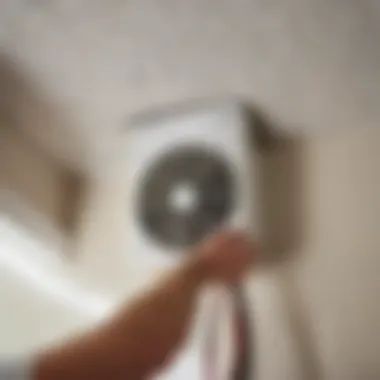Step-by-Step Guide: How to Successfully Replace Your Bathroom Fan


Materials:
- New bathroom fan unit
- Screwdriver
- Voltage tester
- Wire nuts
- Wire connectors
- Mounting brackets
- Duct tape
- Vent cover
DIY Steps:
- Turn off power: Begin by switching off the circuit that powers the bathroom fan to ensure safety during the installation process. Use a voltage tester to confirm that the power is off.
- Remove the old fan: Take out the existing fan by unfastening the mounting screws and disconnecting the electrical wiring. Keep track of how the fan is wired for the replacement.
- Prepare the new fan unit: Assemble the new bathroom fan according to the manufacturer's instructions. Attach any required mounting brackets and ensure all necessary components are in place.
- Install the new fan: Secure the new fan in place, making sure it is level and properly aligned. Connect the electrical wiring using wire nuts and wire connectors, following the wiring diagram provided with the new fan.
- Ventilation duct hookup: Use duct tape to seal any gaps or leaks in the ventilation ductwork. Properly connect the duct to the fan unit to ensure efficient air flow.
Technical Aspects:
- Tools required: Screwdriver, voltage tester
- Timing specifics: Allow 1-2 hours for the complete fan replacement process
- Critical techniques: Double-check all electrical connections, ensure proper ventilation duct alignment
DIY Project Process:
- Sequential Steps: Each step in the installation process is crucial. Focus on aligning the fan correctly, securing it firmly, and testing it post-installation.
- Troubleshooting Tips: If the fan does not turn on after installation, check the wiring connections and power supply. Ensure the ventilation duct is not blocked or obstructed.
Remember, proper installation of a bathroom fan is essential for maintaining good air quality and preventing moisture buildup in your bathroom. Follow these detailed instructions for a successful fan replacement project!
Introduction
In this comprehensive guide on how to change a bathroom fan, we delve into the intricacies of upgrading your bathroom ventilation system. A bathroom fan plays a pivotal role in maintaining air quality, preventing mold and mildew buildup, and eliminating lingering odors. By understanding the importance of a bathroom fan, you can create a more hygienic and comfortable environment within your home. This guide will navigate you through the process of replacing your fan, equipping you with the knowledge and skills necessary to enhance your bathroom's functionality and hygiene.
Understanding the Importance of a Bathroom Fan
A bathroom fan is not merely a luxury but a necessity for a healthy living environment. Its primary function is to expel excess moisture, airborne contaminants, and unpleasant odors from the bathroom space. Without proper ventilation, bathrooms become breeding grounds for mold, mildew, and bacteria, which can pose health risks and compromise indoor air quality. Additionally, a well-functioning fan helps prevent peeling paint, warped wood, and other structural damages caused by excess humidity.
Proper ventilation is essential for maintaining a comfortable and sanitary bathroom environment. The circulation of fresh air prevents musty smells, promotes drying of wet surfaces, and enhances overall cleanliness. By installing and maintaining a bathroom fan, homeowners can improve air quality, preserve the integrity of their bathroom fixtures, and create a more pleasant and inviting space for themselves and their guests.


Signs Indicating the Need for a Fan Replacement
Over time, bathroom fans may exhibit signs of wear and malfunction, signaling the need for replacement. Common signs include reduced airflow, excessive noise, motor failure, or physical damage to the fan unit. These issues can lead to insufficient ventilation, increased energy consumption, and potential safety hazards. By recognizing these indicators early on, homeowners can address fan replacement proactively, safeguarding their bathroom's cleanliness and structural integrity.
Replacing a fan at the first sign of deterioration ensures optimal performance and longevity. Upgrading to a newer, more efficient model not only enhances ventilation but also reduces energy costs and maintenance requirements. By staying vigilant and responsive to these warning signs, homeowners can ensure their bathroom fan operates seamlessly, providing consistent air circulation and humidity control.
Overview of the Replacement Process
The replacement process of a bathroom fan involves several sequential steps to ensure a successful installation. Before commencing the replacement, it is essential to gather the necessary tools and materials, ensure proper safety measures, and turn off the power supply to the existing fan. Identifying and accessing the old fan unit, disconnecting power and wiring, and uninstalling the fan are subsequent steps in the removal process.
For installing the new fan, selecting an appropriate replacement fan, mounting the new unit securely, and connecting electrical wiring correctly are crucial steps for a functional setup. Testing the new fan's functionality, securing it in place, and verifying proper ventilation complete the replacement process. By following these detailed guidelines, homeowners can navigate the fan replacement journey with confidence and achieve a fully optimized bathroom ventilation system.
Preparatory Steps
In the realm of changing a bathroom fan, the preparatory steps stand as a crucial phase in ensuring a smooth and successful fan replacement process. These preparatory measures serve as the foundation for a seamless transition from the old fan to the new, guaranteeing a ventilated and comfortable bathroom environment.
First and foremost, understanding the significance of preparatory steps is essential. By properly preparing for the fan replacement task, individuals can mitigate risks, prevent potential hazards, and streamline the overall process. It establishes a structured approach and sets the stage for a hassle-free installation of the new bathroom fan.
Furthermore, prepping the workspace and gathering all necessary tools and materials in advance is a fundamental aspect of preparatory steps. This includes items such as screwdrivers, wire strippers, a voltage tester, a ladder, and the replacement fan unit itself. By having all essential components at hand, individuals can avoid interruptions during the installation process and ensure a more efficient workflow.
Moreover, ensuring safety measures during the preparatory phase is paramount. This involves wearing protective gear such as gloves and safety goggles, as well as following manufacturer guidelines and recommended practices for handling electrical components. Prioritizing safety not only safeguards individuals from potential injuries but also promotes a secure working environment during the fan replacement procedure.
Lastly, turning off the power supply before commencing any work is a critical preparatory step. This action eliminates the risk of electric shock and ensures that the installation process can be carried out safely. By cutting off the power source to the bathroom fan, individuals protect themselves and prevent any electrical mishaps, emphasizing the importance of this preliminary measure.
Gathering Necessary Tools and Materials
When it comes to changing a bathroom fan, having the right tools and materials at your disposal is imperative to facilitate a successful fan replacement. By assembling the necessary items beforehand, individuals can streamline the installation process and avoid any unnecessary delays.


Key tools and materials required for the fan replacement procedure include screwdrivers (both Phillips and flathead), wire strippers, a voltage tester, a ladder or step stool for elevated access, a new replacement fan unit, and potentially a utility knife. These items are essential for dismantling the old fan, disconnecting wiring, and installing the new unit securely.
It is advisable to double-check the compatibility of the replacement fan with the existing bathroom setup to ensure a seamless installation. Additionally, keeping spare nuts, bolts, and screws handy can be beneficial in case any original components need replacement or reinforcement during the process. By gathering all the necessary tools and materials in advance, individuals can simplify the fan replacement task and enhance efficiency.
Removing the Old Fan
In this crucial stage of the fan replacement process, the focus shifts towards extracting the existing fan unit from your bathroom. The removal of the old fan is a pivotal step that sets the foundation for installing a new and efficient ventilation system. By ensuring the successful dismantling of the old fan, you pave the way for improved air quality and ventilation within your bathroom space.
Identifying and Accessing the Fan Unit
Before proceeding with removing the old fan, it is essential to locate the fan unit within your bathroom. Typically, bathroom fans are situated on the ceiling or wall, near the shower or toilet area. Once identified, you may need to access the fan by removing any covers or grilles that are concealing it. This step ensures a clear view of the fan unit, facilitating a smooth removal process.
Disconnecting Power and Wiring
Ensuring safety during the removal of the old fan is critical, beginning with the disconnection of power to the fan. Prior to any work, switch off the power supply to the bathroom to prevent electrical hazards. Identify the correct circuit breaker or fuse associated with the fan and turn it off. Additionally, use a voltage detector to confirm that the power is indeed off before proceeding to disconnect the electrical wiring connected to the fan unit. This precautionary measure eliminates the risk of electric shock during the removal process.
Uninstalling the Old Fan
With the power disconnected and wiring safely detached, the next phase involves physically uninstalling the old fan unit. Depending on the type of fan installed, this may require unscrewing mounting brackets or fixtures that secure the fan in place. Exercise caution when handling the fan to avoid damage and ensure a smooth uninstallation. Remove any screws or bolts holding the fan housing in position, allowing you to carefully extract the old fan from its place. Thoroughly inspect the area for any remaining debris or obstructions that might impact the installation of the new fan, guaranteeing a clean space for the next steps in the replacement process.
Installing the New Fan
In this crucial stage of the bathroom fan replacement process, the focus is on seamlessly integrating the new fan unit into the existing setup. Installing the new fan is a pivotal step that directly impacts the effectiveness and performance of the ventilation system.
When selecting an appropriate replacement fan, consider key factors such as the fan size, airflow capacity, noise level, and energy efficiency. Ensuring that the new fan matches or exceeds the specifications of the old fan is essential for optimal functionality.
Mounting the new fan unit requires precision and attention to detail. Begin by carefully positioning the fan in the designated location, ensuring secure attachment to the ceiling or wall. Follow the manufacturer's instructions closely to guarantee a stable and reliable installation.


Connecting the electrical wiring is a critical aspect of installing the new fan. Prioritize safety by turning off the power supply before handling any wires. Double-check the wiring connections to ensure proper polarity and secure them tightly. Test the fan once wired to confirm functionality before proceeding to secure it in its final position.
By meticulously following these steps, homeowners can successfully install a new bathroom fan, improving air quality and comfort in the space.
Testing and Finalizing
As we near the completion of this bathroom fan replacement project, testing and finalizing become crucial steps to ensure that everything is in proper working order. Testing the functionality of the new fan, securing the fan unit in place, and ensuring proper ventilation all play a vital role in the success of this endeavor.
Testing the Functionality of the New Fan
After installing the new fan unit, the next step is to test its functionality. This involves turning on the fan to check if it operates smoothly and efficiently. Listen for any unusual sounds that may indicate a problem, and ensure that the fan is effectively ventilating the bathroom. Conducting this test allows you to address any issues before finalizing the installation.
Securing the Fan Unit in Place
Once you have confirmed that the new fan is functioning correctly, the fan unit must be securely fastened in place. Use appropriate screws or brackets to ensure the fan is stable and properly mounted. This step is crucial to prevent any potential hazards or malfunctions due to loose fittings. Take your time to double-check the secure attachment of the fan unit before proceeding.
Ensuring Proper Ventilation
Proper ventilation is essential for maintaining good air quality in your bathroom. Ensure that the fan is adequately positioned to effectively remove moisture and odors from the air. Proper ventilation helps prevent mold and mildew growth, extends the life of your bathroom fixtures, and creates a more comfortable environment. Confirm that the fan is vented to the outside to prevent condensation issues indoors. Taking the time to ensure proper ventilation will significantly benefit your bathroom's overall functionality and longevity.
By focusing on testing the functionality of the new fan, securing the fan unit in place, and ensuring proper ventilation, you can successfully complete the installation process and enjoy a well-ventilated bathroom.
Conclusion
In the realm of changing a bathroom fan, the conclusion plays a crucial role in ensuring a successful upgrade process. As we reach the final stages of this comprehensive guide, it is essential to reflect on the significance and impact of the steps taken. The conclusion serves as the culmination of meticulous planning, precise execution, and attention to detail throughout the replacement journey.
One of the primary elements to consider in the conclusion is the overall improvement in bathroom ventilation. By following the steps outlined in this guide, individuals can expect a significant enhancement in air quality and moisture control within their bathroom space. This translates to a more comfortable and healthier environment for residents and guests alike.
Moreover, the conclusion brings to light the benefits of a well-functioning bathroom fan. Beyond just removing odors and dampness, a new fan contributes to the longevity of the bathroom infrastructure by preventing mold growth, decay, and other issues associated with poor ventilation. A properly functioning fan also aids in maintaining the integrity of paint, fixtures, and other materials within the bathroom.
When wrapping up the fan replacement process, it is crucial to take into account certain considerations. Ensuring that the new fan is securely mounted, all wiring is properly connected, and the unit operates effectively are essential aspects of the conclusion. Additionally, conducting a final check to guarantee proper ventilation and functionality is key to enjoying the results of the replacement in the long term.
To encapsulate, the conclusion of this guide signifies more than just the end of a task – it marks the beginning of a fresh chapter in bathroom maintenance. By implementing the insights provided here, individuals can take proactive steps in safeguarding their living spaces and promoting a healthy indoor environment. The journey from start to finish culminates in a renovated bathroom fan that not only improves functionality but also contributes to overall well-being and comfort.







